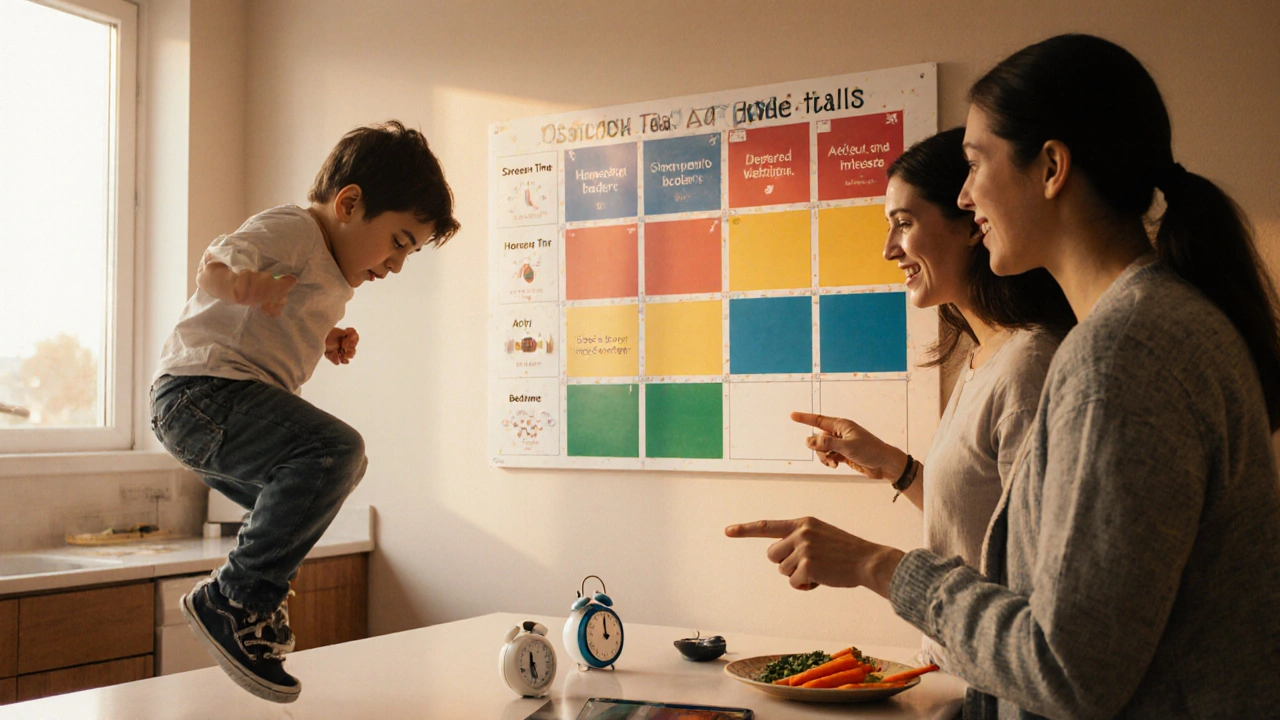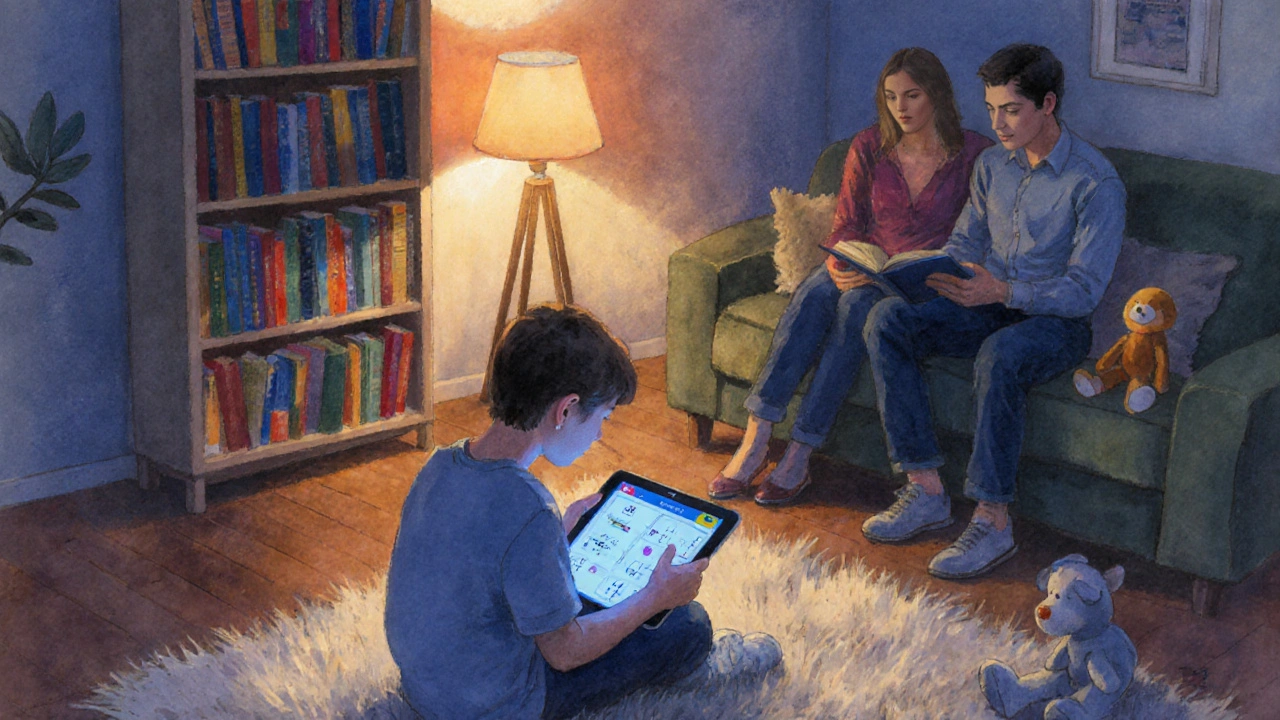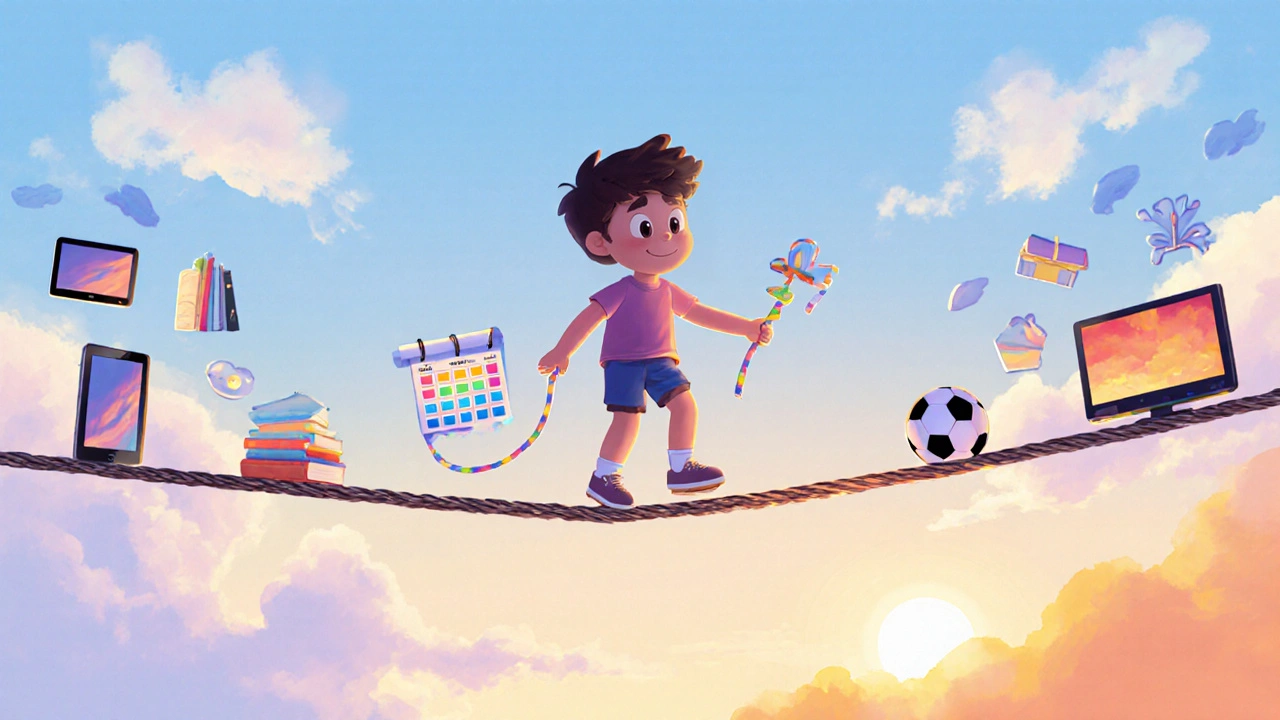ADHD Screen Time Calculator
These recommendations are tailored for children with ADHD to support focus and well-being. Adjustments may be needed based on individual responses.
| Age Group | Max Screen Time | Break Frequency | Recommended Content |
|---|---|---|---|
| 2-5 years | ≤ 30 minutes | Every 10-15 minutes | Interactive storybooks, music videos |
| 6-12 years | 1-2 hours | Every 30 minutes | Educational games, video calls with family |
| 13-18 years | 2-3 hours (including school work) | Every 45 minutes | Homework platforms, moderated social media, skill-building apps |
Key Takeaways
- Screen time can amplify ADHD symptoms, but the right amount can be beneficial.
- Age‑specific limits work better than a one‑size‑fits‑all rule.
- Consistent routines, active breaks, and parental monitoring are essential.
- Focus on content quality, not just quantity.
- Adjust limits as your child’s behavior and needs evolve.
Finding a healthy ADHD screen time balance feels like walking a tightrope. Too much digital exposure can worsen hyperactivity, impulsivity, and sleep problems, yet completely shutting devices off can strip away learning tools and social connections. This guide cuts through the noise, showing parents how to set realistic limits, pick the right content, and create a daily rhythm that supports focus and wellbeing.
ADHD is a neurodevelopmental condition characterized by inattention, hyperactivity, and impulsivity. It affects roughly 9% of children in the United States and often persists into adulthood.
When we talk about screen time - the total minutes a child spends on TVs, tablets, smartphones, or computers - research shows a clear link to dopamine spikes, which can temporarily boost focus but may also deepen the reward‑seeking cycle typical of ADHD.
How ADHD and Screens Interact in the Brain
People with ADHD usually have lower baseline levels of dopamine, a neurotransmitter that regulates motivation and reward. Fast‑moving, brightly colored apps flood the brain with dopamine, providing a short‑term “fix.” Over time, the brain adapts, demanding more stimulation to achieve the same level of satisfaction - a classic feedback loop.
Beyond dopamine, executive function - the set of mental skills that include planning, impulse control, and working memory - often struggles in ADHD. Extended screen sessions can overload these systems, making it harder for kids to transition to less-structured tasks like homework or chores.
Why Screen Time Matters for Children with ADHD
- Attention drift: Rapid scene changes train the brain to expect constant novelty, so slower, sustained activities become a challenge.
- Sleep disruption: Blue light suppresses melatonin, pushing bedtime later and reducing deep‑sleep cycles, which are critical for memory consolidation.
- Behavioral escalation: Overstimulation can increase irritability, leading to more meltdowns or defiant behavior.
- Social impact: Excessive solo screen time may limit real‑world social practice, essential for developing empathy and communication.
That said, not all screens are villains. Educational games that require problem‑solving, interactive storytelling, or video calls with family can reinforce learning and social bonds when used mindfully.

Screen Time Guidelines Tailored for ADHD
The American Academy of Pediatrics (American Academy of Pediatrics) provides general recommendations, but children with ADHD often benefit from tighter caps. Below is a practical framework that blends expert advice with real‑world flexibility.
| Age Group | Maximum Overall Screen Time | Suggested Break Frequency | Preferred Content Types |
|---|---|---|---|
| 2‑5 years | ≤ 30 minutes | Every 10‑15 minutes | Interactive storybooks, music videos |
| 6‑12 years | 1‑2 hours | 5‑minute break every 30 minutes | Educational games, video calls with family |
| 13‑18 years | 2‑3 hours (including school work) | 10‑minute break every 45 minutes | Homework platforms, moderated social media, skill‑building apps |
These numbers are starting points. Observe your child’s mood, sleep quality, and ability to transition between tasks. If you notice heightened restlessness or bedtime battles, trim a few minutes the next day.
Strategies to Find the Right Balance
- Set a visual schedule: Use a wall chart or a free app to plot screen blocks, homework, play, and bedtime. Colors help kids see the flow.
- Prioritize content before time: A 30‑minute math game is more valuable than a 60‑minute cartoon binge. Discuss why the chosen activity matters.
- Incorporate active breaks: Every 20‑30 minutes, stand up, stretch, or do a quick physical activity (e.g., 10 jumping jacks). Physical movement boosts dopamine naturally.
- Use parental monitoring tools wisely: Enable screen‑time limits on devices, but avoid overly punitive lock‑outs that can trigger power struggles.
- Create screen‑free zones: Bedrooms, dinner tables, and the family car should stay device‑free to protect sleep and conversation quality.
- Model balanced behavior: Kids copy adults. If you’re scrolling mindlessly, the lesson is lost.
- Review weekly: At Sunday dinner, discuss what worked, what felt overwhelming, and adjust the schedule together.
Tools & Techniques for Parents
Several free or low‑cost resources make implementation easier:
- Screen‑time dashboards: iOS Screen Time, Android Digital Wellbeing, or third‑party apps like Qustodio provide daily reports.
- Reward charts: Link earned screen minutes to chores or reading milestones.
- Physical timers: A kitchen timer or a smartwatch alarm can signal break time without a parent’s constant reminder.
- Content filters: Use built‑in parental controls to block age‑inappropriate or overly stimulating apps.

Common Pitfalls and How to Avoid Them
- Using screens as a babysitter: Instead, schedule short, purposeful sessions. If you need a quiet moment, try a calming activity like a puzzle for both of you.
- Inconsistent enforcement: Kids with ADHD thrive on predictability. Stick to the schedule even on weekends, with minor flexibility for special events.
- Ignoring content quality: Fast‑paced games can be more disruptive than educational videos. Review apps before allowing regular use.
- Over‑reliance on tech for behavior management: Combine screen limits with positive reinforcement and clear expectations.
Putting It All Together
Balancing screen time isn’t about banning technology; it’s about shaping a routine that respects the ADHD brain’s need for structure, novelty, and physical movement. Start small, track results, and involve your child in the conversation. Over time you’ll see fewer meltdowns, better sleep, and more focus for homework‑time tasks.
Frequently Asked Questions
How much screen time is safe for a teenager with ADHD?
For teens (13‑18), aim for 2‑3 hours per day, including school‑related use. Keep breaks every 45 minutes and prioritize educational or socially interactive content.
Can using a tablet improve attention in ADHD?
Certain apps that require problem‑solving or guided reading can temporarily boost focus, but the effect fades if the device is used for fast‑paced games or passive scrolling.
What’s the best way to enforce screen limits without power struggles?
Create a visual schedule together, use timers for transitions, and offer non‑screen alternatives (e.g., outdoor play, craft kits) during break periods.
Does screen time affect medication effectiveness?
Screen‑induced sleep loss can reduce the efficacy of stimulant meds. Ensuring a screen‑free wind‑down hour before bedtime helps medication work as intended.
Are there specific types of content that help a child with ADHD learn better?
Interactive, multimodal lessons that combine visuals, sound, and immediate feedback (e.g., math games like Prodigy or language apps like Duolingo) tend to hold attention longer than passive videos.



14 Comments
ashish ghone October 9, 2025 AT 23:46
Hey there, I totally get how overwhelming it can feel trying to juggle screen time for kids with ADHD, especially when every app seems to promise a miracle for focus 😊. First, celebrate the fact that you're looking for a balanced approach, because awareness is the first step toward lasting change. Start by creating a visual schedule using bright stickers or a simple chart; this gives kids a concrete sense of what to expect and reduces anxiety about sudden transitions. Next, choose high-quality, interactive content like math games that provide immediate feedback, rather than endless scrolling through TikTok which can overstimulate their dopamine pathways. Remember to keep the sessions short - around 20‑30 minutes for younger children - and enforce a 5‑minute active break with jumping jacks or a quick dance to reset their neural circuitry. During breaks, encourage physical movement; it naturally boosts dopamine without the digital overload. Also, establish screen‑free zones such as the dinner table and bedrooms, which protects sleep quality and promotes family conversation. For bedtime, implement a digital curfew at least an hour before sleep; the reduced blue‑light exposure supports melatonin production and better rest. Customise the schedule as your child grows: what works for a 6‑year‑old may need tweaking for a teenager, so stay flexible and observe mood and behavior cues. Use parental‑control tools sparingly - they’re great for setting boundaries but can backfire if they feel punitive. Celebrate small victories, like a week of smooth transitions, because positive reinforcement reinforces the routine. Keep communication open: ask your child how they feel about the limits and listen empathetically; they’re more likely to buy in when they feel heard. Finally, model balanced screen habits yourself; kids mirror adult behavior, so put your phone away during family time too. Stay patient, stay consistent, and remember that the goal isn’t to eliminate screens but to make them a purposeful part of a healthy daily rhythm 😊.
steph carr October 10, 2025 AT 18:26
What a fantastic guide! I love how it blends evidence‑based recommendations with practical tools that families can actually use. The cultural angle of integrating family video calls is a brilliant way to keep kids connected while still respecting screen limits. I also appreciate the balanced tone – it’s encouraging without being preachy, and the mixed formality makes it feel both professional and relatable. Keep up the great work spreading these helpful tips! 🎉
Vera Barnwell October 11, 2025 AT 13:53
Alright, let’s unpack this. The article does a decent job laying out the basics, but there’s a hidden agenda here – the tech industry is practically waving a white flag, slipping “educational” apps onto our kids’ screens while secretly harvesting data and pushing dopamine‑pumping content. Did you notice how the recommended “interactive storybooks” are often just glossy marketing tools that keep children glued, feeding the attention economy? The so‑called "break frequency" is a clever way to keep the device within arm’s reach, ensuring the brain never truly gets a rest. Moreover, the guidelines slip in the phrase "moderated social media" – who decides what moderation looks like? Corporations! And let’s not forget the obscure link between screen time and medication efficacy; the article mentions it in passing, but the backlash against pharmaceutical companies is rarely discussed. Bottom line: while the tips sound reasonable, they’re packaged to keep us compliant with a system that profits from our children’s attention. Stay vigilant, question the sources, and remember that true balance might mean stepping away from screens altogether.
David Ross October 12, 2025 AT 09:20
Great points, Ashish! I especially love the idea of a visual schedule – it adds structure and makes transitions smoother for kids with ADHD; keep it up!
Henry Seaton October 13, 2025 AT 04:46
Steph’s advice is fine but we need to stop letting foreign apps dominate our kids’ minds. Use local content.
Baby Thingie October 14, 2025 AT 00:13
Stick to the schedule; it works.
Abby Elizabeth October 14, 2025 AT 19:40
omg this article is sooo basic omg i cant even lol like why are we still talking about screen time like its 2010? i mean seriously, get with the program, kids who spend any time on a device are basically digital zombies and the whole "break every 30 minutes" thing is just a lame excuse for parents to feel like they did something.
Mark Haycox October 15, 2025 AT 15:06
The so‑called "guidelines" are just a smokescreen for the tech giants pushing their agenda. Parents should reject these recommendations and enforce strict bans on all devices.
Michael Taylor October 16, 2025 AT 10:33
Wow, what an uplifting read!; the detailed breakdown of age‑specific limits is spot on,; I especially love the emphasis on active breaks,; they really help reset the brain’s reward system,; and the suggestion to use visual charts is brilliant,; don’t forget to celebrate each small victory with a fun family ritual,; this positive reinforcement can make the whole routine feel less like a chore and more like a shared adventure,; keep spreading this optimism,; let’s keep our kids thriving in a balanced digital world!!!
Troy Brandt October 17, 2025 AT 06:00
Vera, you bring up some crucial concerns, and I’d like to add that incorporating hands‑on activities during breaks-like building a Lego set or drawing-can further help the executive function pathways while still keeping the child engaged. Also, monitoring the emotional tone of the content is essential; calm, narrative‑driven apps tend to support attention better than rapid‑fire gaming loops.
Barbra Wittman October 18, 2025 AT 01:26
Oh, look, another list of “best practices” that will magically fix everything-because clearly a table can solve the complex neurobiology of ADHD. Sure, let’s all draw adorable charts and pretend we’ve mastered the art of parenting in a few sentences. If only it were that simple, we’d all be sipping lattes while kids blissfully stare at their screens, right?
Gena Thornton October 18, 2025 AT 20:53
If you're looking for a concrete tool, try using a free timer app that signals both the start and end of a screen session with a gentle chime; pairing that with a checklist of approved activities can keep kids accountable without constant parental nagging.
Lynnett Winget October 19, 2025 AT 16:20
Your suggestion to use colorful stickers on a schedule is pure genius-nothing brightens a child’s day like a burst of rainbow‑hued motivation that says, “You’ve earned this!” Keep sprinkling those creative ideas; they make the whole routine feel like an adventure rather than a chore.
Nitin Chauhan October 20, 2025 AT 11:46
Excellent suggestions, Michael-let’s keep the momentum going with short, high‑energy activities during breaks; a quick sprint or a dance burst can recharge focus without needing any screens.